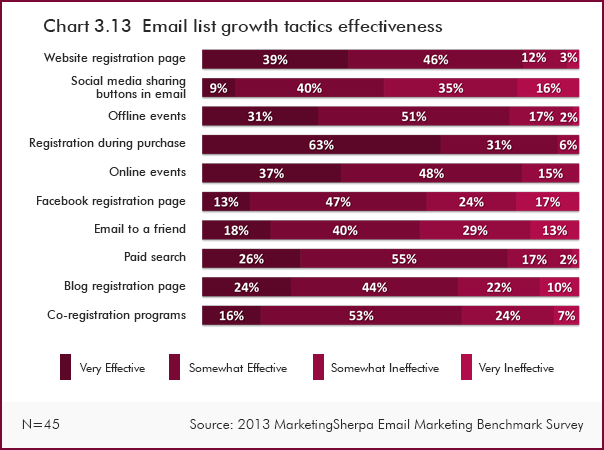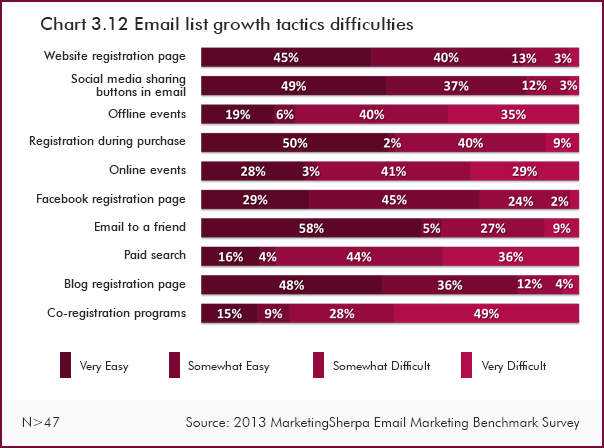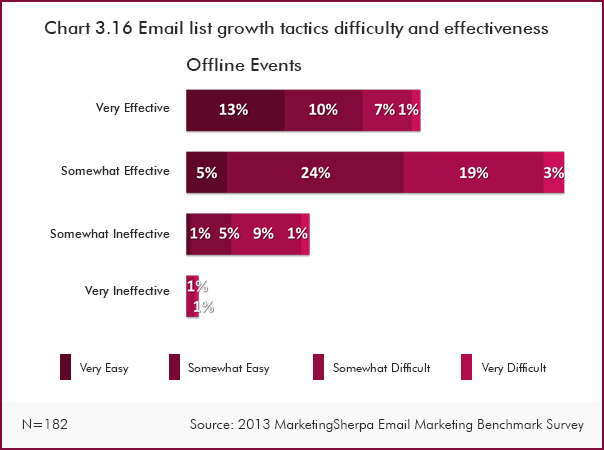by
Daniel Burstein, Director of Editorial Content
In the
MarketingSherpa Email Marketing Benchmark Report survey, we asked marketers:
Q. Please indicate the level of EFFECTIVENESS for each of the email list growth tactics your organization is using.
Click here to see a printable version of this chart
We also asked marketers about the difficulty of these tactics:
Q. Please indicate the degree of DIFFICULTY (time, effort and expense) for each of the email list growth tactics your organization is using.
Click here to see a printable version of this chart
Ask the right questions to get the right answers
"What do you do when you sit down to think of an email acquisition strategy?" Mary Abrahamson, Email Marketing Specialist, Ferguson Enterprises, asked.
I'll be interviewing Mary Abrahamson on the main stage at
Email Summit about her award-winning campaign. Abrahamson attended Email Summit last year, put what she learned into practice, and this year will be accepting the MarketingSherpa Award — Best B2B Email Campaign for a campaign that generated more than $21 million in online sales (and counting).
In working with Abrahamson on the presentation for Email Summit, we discussed the above data about list building.
"I feel a lot of marketers answer these questions with the thought of 'What was easiest to implement?' or 'How am I going to get the most people?' However, having this type of thought-process isn't always most effective when it comes to choosing your email acquisition strategy."
What questions should you be asking? Here are the questions Abrahamson asked when formulating Ferguson's list-building strategy (I've also included some of her quick thoughts on those questions):
Four questions to ask when you begin developing your email acquisition strategy
Where are your customers?
Analyze where customers are already engaging with your brand and learn how to enhance those experiences for email acquisition.
Where will they feel most comfortable providing the key pieces of information you need?
Whether it be a difference in channel, execution in your form or mobile optimization, the experience the customer has in providing your brand their information is key.
Who are your lowest-hanging fruit customers?
Perhaps they are those that attend events or frequent readers of your blog. Regardless of the type, be sure you aren't just searching for any and every one.
What type of customer information is most valuable to you?
It is important to nail down a limited number of fields that you can absolutely not segment without. That way, you can be sure you require that information upfront, and you can possibly go back to ask for those additional pieces of information at a later time.
"Tie the bridge between what your customers are comfortable with, what will provide them with the experience they are looking for and what marries with your email acquisition needs," Abrahamson said. By taking this approach, Abrahamson discovered that offline events were an underutilized list-building tactic at her company.
Using offline events to grow your list
If you look at the above charts in this article, you'll see that "Offline Events" was ranked as the third-most difficult list-building activity (as ranked by people who said it was "Very difficult"), and it was the fourth-most effective activity (as ranked by people who said it was "Very effective").
Here is a closer look at what marketers had to say about offline events as a list-building activity:
Q. Please indicate the degree of DIFFICULTY (time, effort and expense) and the level of EFFECTIVENESS for each of the email list growth tactics your organization is using.
Click here to see a printable version of this chart
"At Ferguson, our customers live for in-person events. These events range from cooking demos to on-site training to vendor trade shows," Abrahamson said.
"These events take a lot of time and resources to put on, and without the knowledge of who is attending these events, we lack the ability to determine the true value of the event and attendee. This is where email acquisition comes in — the idea of moving from an opt-in concept to a registration concept," she explained.
Ferguson hosts nearly 90 individual Ferguson Rewards Trade Show events every year and was using a manual process for event registration and sending emails after the event. Also, its customers (for example, plumbers and other tradesmen) tended to be more comfortable with traditional paper-based processes and weren't always providing email addresses upon attending the event.
Abrahamson helped shift the process to a Web-based registration app that not only provided a seamless check-in experience the day of the event, but also a segmented follow-up communication on a set schedule with these customers post-event.
Then, once at the event, there was a quick check-in option if they pre-registered via email. For those who didn't, every event had a number of tablets with a registration app so they were capturing an email address from all attendees, instead of only those who went out of their way to volunteer it.
Know thy customer
Why did it work? Because Abrahamson began with the customer in mind.
She made sure to collect enough vital information during the registration that would enable powerful segmentation to give customers information they would find valuable via email after the event (and, using that email address as a single identifying piece of information, that could be correlated back to the database to get an understanding of who was attending these events).
Even something as simple as including an attachable keyboard to the tablets helped bridge the gap between technology-averse customers who tended to have "man hands," which made tablet use frustrating. The quick, easy signup at the offline events could then be quickly incorporated into the database and begin fueling an automated nurturing campaign.
Disregard the "difficulty" chart
As a final piece of advice, Abrahamson encouraged marketers not to focus too much on the perceived difficulty of a list-building tactic and, instead, focus on the quality and robustness of data and leads you can acquire by using the right tactics for your unique customers.
"Acquiring the email addresses of your most valuable customers isn't always the easiest task to master — correctly. I certainly don't recommend that you miss valuable opportunities to acquire new email addresses. However, as companies acquire new opt-ins, they can also come with new challenges. They may face heightened disengagement, excessive data and a decentralized view of the customer," she said.
"This all depends on how and where you acquire these new opt-ins. So as you begin your planning process [and answer the four questions in the article above], don't always look for the easiest way out," Abrahamson concluded.
Related Resources
B2B Email Marketing: Ferguson Rewards trade show optimization achieves over $10 million2015 MarketingSherpa Award winners (presented by BlueHornet)
Email List Growth: 230% more readers from six-channel testEmail Statistics Report, 2011-2015 (by The Radicati Group)
Improve Customer Acquisition and Retention by Combining Triggered Email and Outbound Promotions: 4 StepsMarketingSherpa Email Summit 2015 — February 23-26 at the ARIA Resort & Casino in Las Vegas












